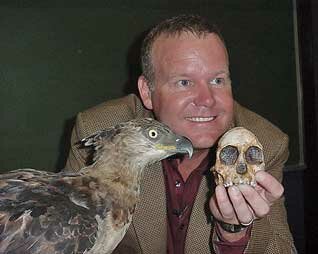But just in case you are out there and need to write one of your own, here is a handy template you can use, based on my experience.
**********
The Mainstream Media Missing Link Article Generator
University of ________ scientists say they’ve found a “missing link” that could help to rewrite the history of human evolution.
Experts called it (exciting/wonderful) and said it fills a crucial gap in the fossil record. The ___ million-year-old creature was not a direct ancestor of modern humans but will allow scientists to answer key questions about what our early ancestors looked like, said researcher ________. If it is confirmed as a missing link between __________ and __________, it would be of immense scientific importance, helping to fill in a gap in the evolutionary history of modern man.
Professor _____ _____, an eminent _______ at ______ University who wasn’t involved in the research, welcomed the find. “The discovery is the most important find since ________ and fills a critical evolutionary gap,” he said.
_______ and ______ experts have remained silent about the exact details of what they have uncovered, but the scientific community is already (abuzz/alight/aflutter) with anticipation of the announcement of the find when it is made on ________.
**********
Clever, right? Well, I am not the first one to do it. Science detractors have created dozens of these because the mainstream media makes it so darn easy by claiming finds of unconfirmed lineage and composed of numerous skeletons are 'missing links'. It's really a disservice to the public because it erodes confidence in science.
So what do we know about this new find, other than headlines like Missing link between man and apes found in The Telegraph? Well, not much. It has no name - and we know that can be a problem - and few have seen it outside Professor Lee Berger's team from the University of the Witwatersrand, who found it a limestone cave known as Malapa cave in the Sterkfontein region of South Africa near Johannesburg.
The Telegraph describes is as an "almost-complete fossilised skeleton" but people need to understand this is a not a preserved skeleton, instead it is a composite of individual fossils found in the same area. We also know that "a major media campaign with television documentaries is planned" which is a red flag for scientists but doesn't disqualify the significance of a find. Disclosing there will be a documentary before it even has a name is odd.

Professor Lee Berger
Obviously fossils with convenient links between Australopithicus (Australopithecus anamensis, Australopithecus afarensis and Australopithecus africanus), 4 million years old or so, and modern humans (Homo habilis some 2.5 million years ago) would be terrific, though not really necessary. Paleontology is not some Supreme Court of science in which nothing is valid unless a fossil is found. Fossilization is a tricky process, after all and doesn't happen in convenient linear timestamps.
And there are debates about where a 'missing link' would fit anyway - some hominins have been found that are older than the youngest common ancestor our gene clock says should exist on the time between the split of humans and chimpanzees. But the debates are the strength of science, not a weakness and biology will converge on better answers to crucial questions - it does not take a 'paleo-anthropologist' to confirm it.
So enjoy the media hype this week. For every skeptic who uses the media frenzy without any independent confirmation as a weapon against science, dozens more will be fascinated by the search - the destination may be unknown but science is a terrific road to travel.




Comments